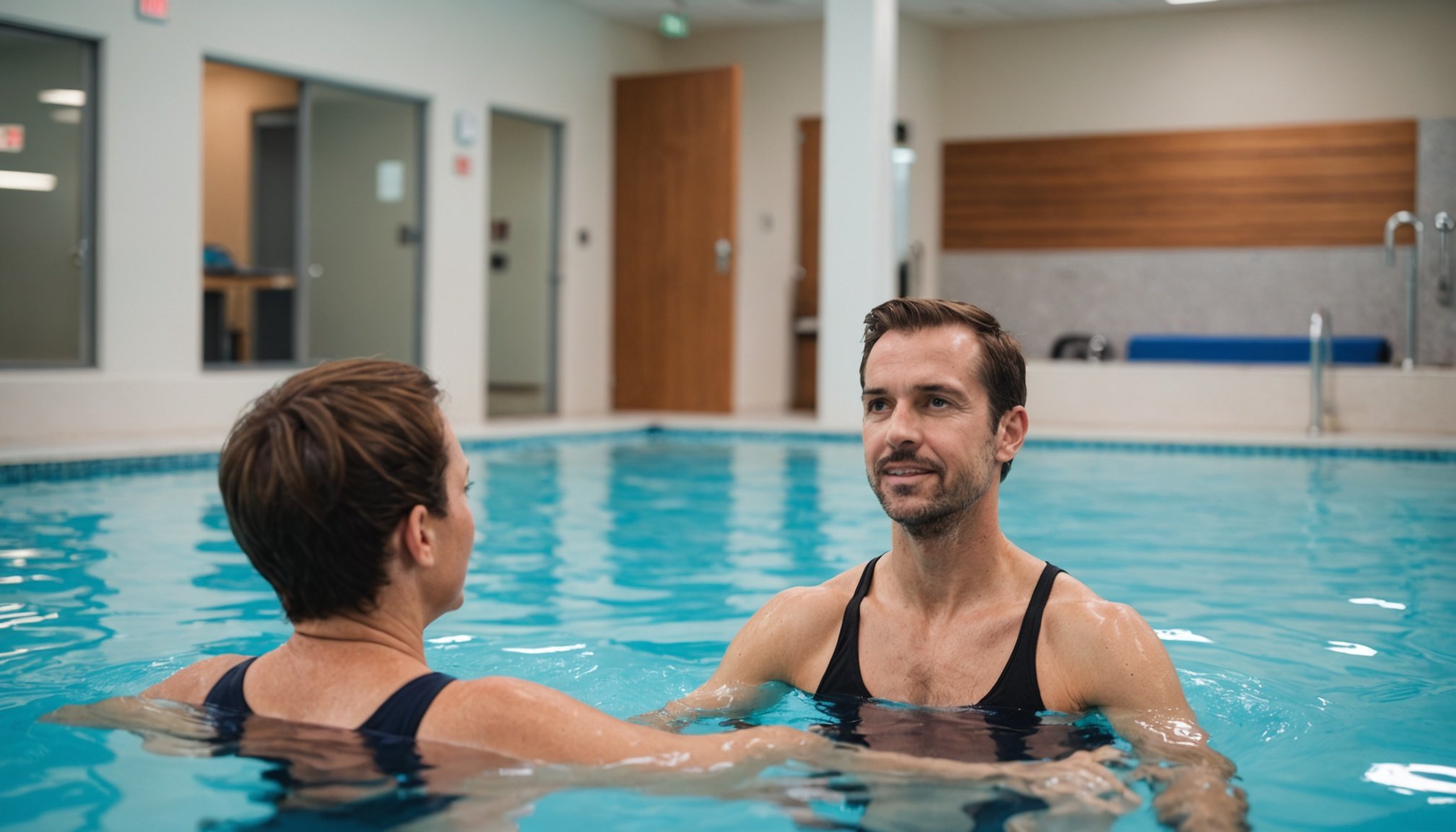Overview of Aquatic Therapy
Aquatic therapy is a specialized form of physical therapy that utilizes the unique properties of water to assist in the rehabilitation process. Historically, water-based treatments have been used for centuries, often praised for their therapeutic benefits. This form of therapy began gaining significant traction in the 20th century, evolving into a distinct discipline within the field of rehabilitation.
The key principles of water-based rehabilitation center around the buoyancy, resistance, and thermal properties of water. Buoyancy helps reduce the strain on joints and tissues, allowing individuals to exercise with less pain and effort. This is particularly beneficial for patients with chronic back pain who may find traditional land-based exercises too strenuous. The resistance of water provides a gentle yet effective way to build muscle strength and endurance, while the warmth of water can enhance circulation and reduce muscle spasms.
Also read : Growing happiness: how community gardening boosts mental wellness and fosters connection
Common techniques used in aquatic therapy include the Halliwick method, Ai Chi, and Bad Ragaz Ring Method. These approaches offer various exercises and movements designed to maximize the therapeutic benefits of water-based rehabilitation.
Benefits of Tailored Aquatic Therapy for Chronic Back Pain
Tailored aquatic therapy offers unique benefits for individuals dealing with chronic back pain, making it an effective tool in pain management. The buoyancy provided by water supports the body, reducing stress on the spine and allowing for exercise that minimizes discomfort. This relief is particularly valuable, as it can lead to a notable reduction in pain and muscle tension.
Also to discover : Enhancing social connections: how pet-assisted therapy empowers children with autism
Beyond pain alleviation, patients often experience improved mobility and flexibility through regular aquatic therapy sessions. The gentle resistance of water aids in strengthening muscles and enhancing range of motion without exacerbating existing pain. This makes it possible for patients to perform exercises they might otherwise avoid on land.
Moreover, the warm water utilized in many pools fosters enhanced relaxation, contributing to overall mental well-being. This soothing environment helps reduce anxiety and stress, promoting a more holistic approach to treatment. Patients often report increased feelings of calmness and satisfaction, aiding in their journey towards recovery.
In summary, aquatic therapy offers a comprehensive solution for managing chronic back pain by promoting physical recovery and mental relaxation, ultimately enhancing the quality of life for those suffering from this condition.
Case Studies and Personal Experiences
Exploring aquatic therapy testimonials can provide valuable insights into its effectiveness. Real-life accounts demonstrate how this form of therapy aids in managing chronic pain and improving mobility.
Real-Life Case Study: Patient A
Patient A, diagnosed with chronic back pain, began water-based rehabilitation focusing on low-impact exercises. Within weeks, they reported noticeable improvements in pain reduction. The buoyancy allowed for more freedom of movement, which contributed significantly to their relief.
Real-Life Case Study: Patient B
Patient B’s experience highlighted the flexibility of personalized treatment plans in aquatic therapy. Initially skeptical, they quickly noticed increased muscle strength and endurance. The warmth and resistance of the water aided in achieving this success.
Collated Testimonials
These treatment success stories collectively emphasize the versatile benefits of aquatic therapy. Patients often mention enhanced relaxation and a boost in mental well-being. Such personal journeys underscore the therapy’s efficacy in fostering holistic recovery. From improved flexibility to enduring relief from discomfort, these experiences illustrate the rewarding outcomes that can be achieved through dedicated participation in aquatic therapy sessions. These testimonials not only build trust but also motivation for others considering this therapeutic approach.
Expert Insights on Aquatic Therapy
Delving into expert opinions provides a deeper understanding of aquatic therapy’s potential. Healthcare professionals specializing in this field emphasize its unique benefits for chronic pain conditions. Physical therapists often highlight how aquatic therapy research supports its efficacy, pointing to studies demonstrating significant improvements in mobility and pain levels. These findings help reassure patients of the merits of this rehabilitation method.
One intriguing aspect is the adaptability of aquatic therapy. Practitioners often cite its broad applicability across different demographics, making it a versatile tool in their therapeutic arsenal. Healthcare professional insights suggest that the water’s properties can be tailored to meet specific needs, offering bespoke rehabilitation solutions.
Professionals further advocate for the integration of aquatic therapy in comprehensive treatment plans. Recommendations typically include regular assessments to ensure the therapy remains aligned with individual progress and goals. Interviews with specialists reveal that ongoing research continues to refine techniques, enhancing outcomes for numerous patients.
By considering these expert insights, those interested in aquatic therapy can approach it with informed confidence, recognizing its potential role in comprehensive healthcare strategies.
Finding Tailored Aquatic Therapy Programs
Locating the right aquatic therapy program is essential for effective rehabilitation, especially for those seeking relief from chronic back pain. Begin your search by exploring local therapy centers known for their personalized water-based rehabilitation plans. Online reviews and testimonials can provide valuable insights into the experiences of past patients.
When approaching potential facilities, it’s crucial to ask the right questions. Discuss the qualifications of the therapists, the range of personalized programs available, and how they assess individual needs. Understanding the treatment process will help in determining if their approach aligns with your rehabilitation goals.
Assessment procedures play a key role in creating tailored programs. Facilities that focus on customizing therapy plans often start with a comprehensive evaluation of your condition. This ensures the exercises are specifically designed around your unique requirements, maximizing the therapeutic benefits.
Additionally, don’t hesitate to inquire about the duration and frequency of sessions recommended for optimal results. A clear understanding of these aspects will empower you to make informed decisions and engage in a routine that significantly enhances your recovery journey.
Visual Resources and Engagement Tools
Incorporating visual resources into your aquatic therapy experience can significantly enhance learning and engagement. These instructional imagery and therapy demonstrations are invaluable for understanding complex techniques and ensuring proper form. Many platforms now offer comprehensive aquatic therapy videos that provide step-by-step guidance, ensuring participants can follow along confidently.
Importance of Visual Learning in Therapy
Visual learning tools are crucial for grasping the nuances of water-based healing techniques. They help bridge the gap between theory and practice, giving patients a clear view of exercises tailored for chronic back pain relief and water-based rehabilitation. Visual resources break down each movement, allowing users to replicate them accurately in the pool.
Types of Visual Resources Available
There is a wide range of resources available, including high-quality videos, 3D animations, and illustrated guides. These materials cater to various learning styles, ensuring effective comprehension for all users. Therapy demonstrations are particularly beneficial, showcasing real-life applications of aquatic exercises.
Recommendations for Online Platforms and Resources to Explore
When exploring online platforms, look for those that offer comprehensive and well-reviewed content to ensure trustworthy guidance. Reliable sources often include professional medical organizations or specialists in aquatic therapy for chronic back pain. Always verify the credentials of those providing the content to maintain safety and efficacy.

